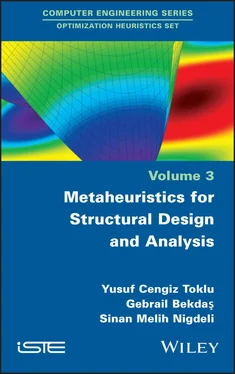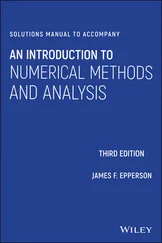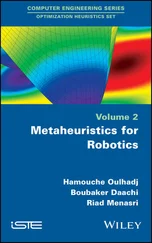Yusuf Cengiz Toklu - Metaheuristics for Structural Design and Analysis
Здесь есть возможность читать онлайн «Yusuf Cengiz Toklu - Metaheuristics for Structural Design and Analysis» — ознакомительный отрывок электронной книги совершенно бесплатно, а после прочтения отрывка купить полную версию. В некоторых случаях можно слушать аудио, скачать через торрент в формате fb2 и присутствует краткое содержание. Жанр: unrecognised, на английском языке. Описание произведения, (предисловие) а так же отзывы посетителей доступны на портале библиотеки ЛибКат.
- Название:Metaheuristics for Structural Design and Analysis
- Автор:
- Жанр:
- Год:неизвестен
- ISBN:нет данных
- Рейтинг книги:4 / 5. Голосов: 1
-
Избранное:Добавить в избранное
- Отзывы:
-
Ваша оценка:
- 80
- 1
- 2
- 3
- 4
- 5
Metaheuristics for Structural Design and Analysis: краткое содержание, описание и аннотация
Предлагаем к чтению аннотацию, описание, краткое содержание или предисловие (зависит от того, что написал сам автор книги «Metaheuristics for Structural Design and Analysis»). Если вы не нашли необходимую информацию о книге — напишите в комментариях, мы постараемся отыскать её.
Metaheuristics for Structural Design and Analysis — читать онлайн ознакомительный отрывок
Ниже представлен текст книги, разбитый по страницам. Система сохранения места последней прочитанной страницы, позволяет с удобством читать онлайн бесплатно книгу «Metaheuristics for Structural Design and Analysis», без необходимости каждый раз заново искать на чём Вы остановились. Поставьте закладку, и сможете в любой момент перейти на страницу, на которой закончили чтение.
Интервал:
Закладка:
The flowchart of this process is shown in Figure 1.1. It should be noted that the algorithm represented in this chart is not fully applicable, even in our age, though engineers are close to using it only for some simple structures. We can estimate that full use of the algorithm shown will be possible with advances yet to be made in the field known as artificial intelligence.
In the early ages, there was of course no knowledge about concepts such as stress, strain, force, deformations, stability, buckling, bending and torsion. Formulating a mathematical model of the structure was unthinkable, and there was no knowledge of calculus to do any kind of computation. Despite all of this, there was the intuition, experience, intelligence and observation power of some extraordinary people.
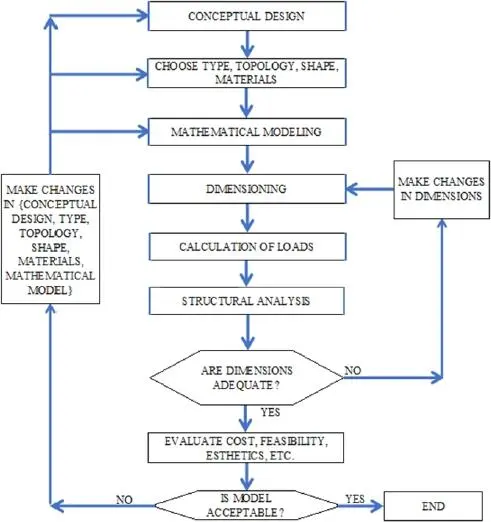
Figure 1.1. General flowchart for structural design
In the beginning, the above algorithm comprised only the first step shown; the engineers/architects started building structures based only on conceptual design: a temple, a ziggurat, a pyramid, an obelisk, etc. and made improvements to their designs, according to their feelings, as construction went on. The most important characteristic of the flowchart shown above is the existence of iterations at various steps. It is easy to assume that iterations during these early times were being performed in the field, i.e. during the construction process. Perhaps tens of years or more were necessary for field iterations for the cutting of stones; carrying them to their places, carving figures wherever necessary, placing small stones and erecting T-shaped columns at Göbeklitepe – the first known edifices of humankind, recently uncovered at Urfa, Turkey – built some 12,000 years ago (see Figure 1.2).
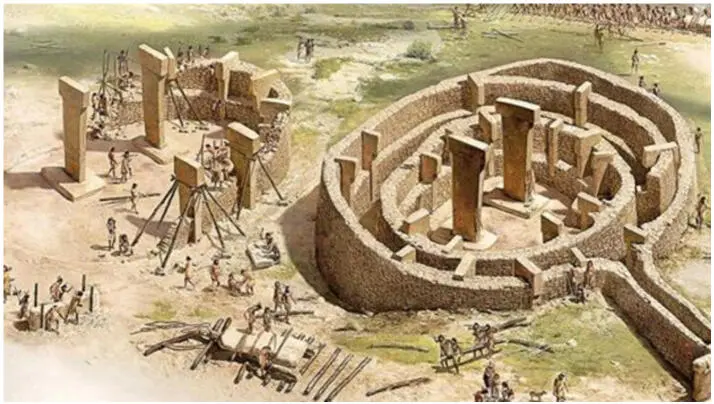
Figure 1.2. Representative drawing showing construction operations at Göbeklitepe, Urfa, Turkey (https://www.cnnturk.com/kultur-sanat/dunyanin-en-eski-tapinagi-gobekli-tepe?page=1). For a color version of this figure, see www.iste.co.uk/toklu/metaheuristics.zip
We also see field iterations in structures that have collapsed and been rebuilt. The best example that can be given from those years is the Hagia Sophia (see Figure 1.3) in Istanbul, Turkey, which was constructed between February 532 and December 537, following the design created by Anthemius of Tralles and Isidorus of Miletus (Mainstone 1988; Ozkul and Kuribayashi 2007; Çakmak et al . 2009). This design was carried out using the experience and intuition of the two architects, perhaps with some computations with respect to the sizes of the columns. It was not possible to perform the computational iterations depicted in Figure 1.1, but they forcedly took place to end up with a safe structure. In May 558, i.e. almost 20 years after construction had finished, “parts of the central dome and its supporting structural system collapsed” (Çakmak et al . 2009). Those failures were probably due to earthquakes that took place in August 553 and December 557. Subsequently, a new dome – approximately 6.24 m higher than the original – was designed by Isidorus the Younger, nephew and successor to Isidorus of Miletus. This can be considered as an iterational process on the conceptual design of the structure, performed in the field as a real construction.

Figure 1.3. Current photo of Hagia Sophia in Istanbul, Turkey. For a color version of this figure, see www.iste.co.uk/toklu/metaheuristics.zip
The real iterations started with advances in structural analysis; its history written by Timoshenko (1983), Benvenuto (1990), Mainstone (1997), Felippa (2001), Addis (2003), Kurrer (2018) and many others.
Strength of materials is a primordial field in structural analysis. Following an introduction that charts its early beginnings, Timoshenko (1983) – in his book originally published in 1953 – explores the history of this subject across 14 chapters, beginning with the 17th century and ending with the period 1900–1950.
Mainstone (1997) states that structural analysis, as we now know it, began in the 18th century to assess the safety of buildings to be constructed. By the mid-19th century, this area is extended for analyzing earlier structures like Gothic cathedrals. The first idealization was Hooke’s law of direct proportionality; this idealization went together with increasing knowledge about statically determinate structures, ignoring those that were statically indeterminate or hyperstatic. The second half of the 19th century was marked by graphical methods.
Matrices hold a particularly important place in the history of analyses of structures. Felippa (2001) addresses this aspect under three titles: creation, unification and FEMinization, the last term meaning the launching of “[...] the direct stiffness method [...] as an efficient and general computer implementation, as yet unnamed, finite element method (FEM)”. Addis (2003) states that the main causes of failure in historical structures were wind loads, foundation problems and fires. We must add earthquakes to these effects for some parts of the world. Addis mentions the importance of full-scale tests on small physical models in historical times.
Two books, authored by Benvetuno (1990) and Kurrer (2008), are especially remarkable in following the history of structures. In both, the subject is traced from the very first works up until the time each book was written, dividing the advances into eras with historical drawings and anecdotes. Benvetuno’s book is in two parts: “Statics and resistance of solids” and “Vaulted structures and elastic systems”. Kurres’s book, titled The History of the Theory of Structures – From Arch Analysis to Computational Mechanics was published originally in German, in 2002.
Although the design, analysis, and construction of structures have always shown continuous advances in history, there was a period when this was the opposite. Indeed, between the time of the Romans and the Renaissance, let aside making of constructions more important than in previous times, the knowledge accumulated until then was lost (Timoshenko 1983).
1.2. From empirical rules and intuition to FEM
In the beginning, the design of all types of edifices was being carried out without any form of analysis since structural calculations were not available by any means. Due to the field iterations mentioned in the above sections, some empirical rules were being brought forward, which were, mostly geometric (Cowan 1977). An example of these rules is the one about vaults (see Figure 1.4) noted by Leonardo de Vinci (1452–1519). This stated that the chords connecting the top of the structure to the extreme points at the bottom should not cross the inner arch, in order to prevent failure (Benvenuto 1990, p. 9).

Figure 1.4. Empirical rule on vaults: lines ab and bc will remain within the wall
Empirical rules were in use until the 18th century. As time went on, structural computations began to come onto the scene. One of the starting points of this trend, advanced by Robert Hooke (1635–1703), was the rule “ ut tensio, sic vis ”, “extension is directly proportional to force”, which was the starting point of the theory of elasticity. We can assume that iterations of structures have begun, first in terms of dimensions, second in terms of shapes, with the introduction and advent of structural computations. But since the structural theory was only at a primitive level, and computational tools were not available, the iterations were very naïve at the beginning. A method known as the cross method, advanced in 1930 by Hardy Cross (1885–1959), which is technically known as the “moment distribution method”, became a very important tool for engineers in structural computations (Cross 1930; Eaton 2001). The introduction of computers in 1960 enabled designers to do their computations in a much more efficient way. Finally, the FEMinization, defined above, being advanced towards the end of that decade (Felippa 2001), enabled engineers to analyze all types of structures in a very efficient way, eliminating the fear of a higher number of unknowns and of complex structures.
Читать дальшеИнтервал:
Закладка:
Похожие книги на «Metaheuristics for Structural Design and Analysis»
Представляем Вашему вниманию похожие книги на «Metaheuristics for Structural Design and Analysis» списком для выбора. Мы отобрали схожую по названию и смыслу литературу в надежде предоставить читателям больше вариантов отыскать новые, интересные, ещё непрочитанные произведения.
Обсуждение, отзывы о книге «Metaheuristics for Structural Design and Analysis» и просто собственные мнения читателей. Оставьте ваши комментарии, напишите, что Вы думаете о произведении, его смысле или главных героях. Укажите что конкретно понравилось, а что нет, и почему Вы так считаете.
